Robots, Pizza, And Sensory Overload: The Chuck E. Cheese Origin Story
In May 1977, a new pizza place opened for business in San Jose, California. At the time, calling it “unique” might have been an understatement. The brainchild of Atari cofounder Nolan Bushnell–and, initially, an arm of that company–it featured entertainment provided by a cast of robotic characters led by a giant cigar-smoking rat with a bowler, buck teeth, and a Jersey accent. The place–as much a strip-mall Disneyland as an eatery–was called Pizza Time Theatre, and the rodent was known as Chuck E. Cheese.
Over the past four decades, the Chuck E. Cheese franchise has lived out many lives. It began as Bushnell’s effort to give arcade games a family-friendly home in an era when arcades were associated with teenagers who might be up to no good. As it grew, it became an exercise in high-stakes capitalism. And eventually–long after Bushnell’s departure–it became a tame, emotionally sanitized playpen for small children. Today, more than 30 years after Bushnell left the company, there are over 600 Chuck E. Cheese locations, but only remnants remain of his quirky vision.
During the early years of Pizza Time Theatre–the chain officially became Chuck E. Cheese’s in the 1990s–its colorful, high-energy atmosphere very much reflected the personality of its progenitor. Bushnell, who craved new and exciting sensory experiences, saw the restaurant as speaking to something deep in the human soul. “Throughout history there was a celebration, and the celebration had food, drink, and games, without exception,” he explains. “Whether you were talking about the summer solstice with primitive man to the circuses in Rome. There was always an entertainment element. I always felt that was something that was lacking in restaurants. I wanted to add a dimension of fun to the act of having a meal.”
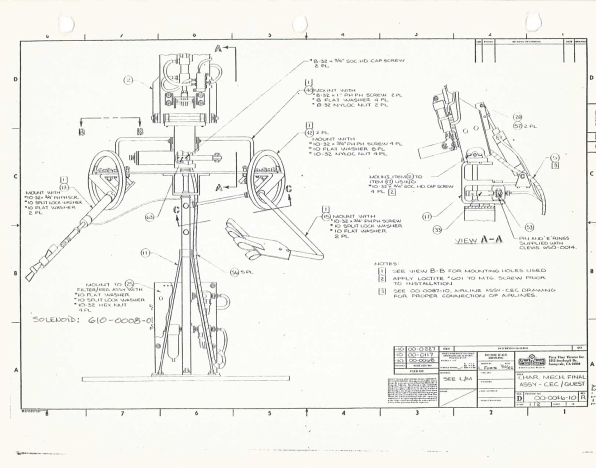
Just five years before launching Chuck E. Cheese, Bushnell had conjured speedy success with Atari–another cultural touchstone–which launched a nationwide sensation with its hit arcade game Pong. Video games made his fortune, but few people know that the restaurant idea actually came first.
The idea that became Pizza Time “was [Bushnell’s] dream,” says Ted Dabney, who cofounded Atari with Bushnell and witnessed his early brainstorms firsthand. “That was the beginning of everything. He didn’t even think about a video game until later.”
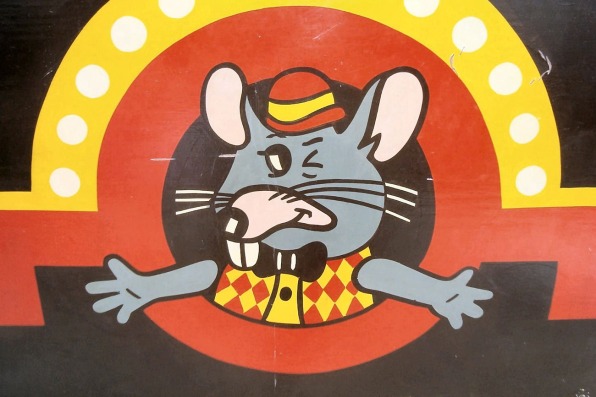
Pizza And … Talking Beer Barrels?
When Bushnell arrived in California, fresh out of the University of Utah in 1969, he was already talking about starting a restaurant. During regular matches of the board game Go with Dabney, his officemate and friend at the legendary Silicon Valley firm Ampex, the pair would hash out plans for Bushnell’s most ambitious ideas. In the early years of their partnership, Dabney served as an important creative foil and hands-on implementer of Bushnell’s visions.
“We’d go around to different restaurants, look at them, see what we could do, and how it would work–that kind of thing,” says Dabney.
In their search, Bushnell kept emphasizing the idea of a carnival theme. “Nolan had worked his way through college at a carnival park,” says Dabney. “He liked that kind of atmosphere, and he always wanted to build a restaurant that had that in it. His whole thing was a pizza parlor with talking beer barrels.”
As Dabney and Bushnell began working on Computer Space–the world’s first commercial coin-operated video game–in 1970, Bushnell kept his restaurant plan in his back pocket. After founding Atari with Dabney in 1972, the breakout success of Pong further delayed his restaurant plans.
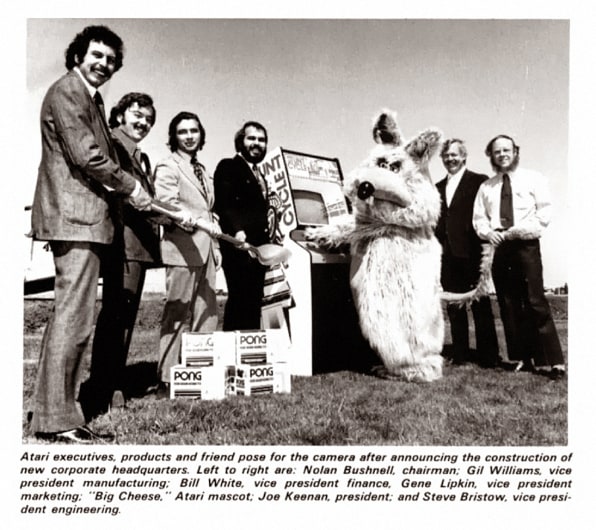
It’s hard to imagine founding a $90 billion industry like the video game business incidentally on the way to starting a carnival restaurant. Bushnell had hit the right idea at the right time with Atari; the success and growth that resulted stunned everyone involved. But it never took him off his track.
“When I was starting Atari, I was actually thinking that I was going to start a restaurant alongside it,” says Bushnell. “I got so busy that it wasn’t until later on in Atari that I decided to finally do the restaurant.”
As game after game rolled off the line during Atari’s early years, Bushnell kept ruminating on his restaurant plan. It occurred to him that his restaurant could also serve as an Atari-controlled outlet for its products, giving the company end-to-end control over its entertainment experience. “I basically hated the way my games were being presented to the public,” Bushnell told the New York Times in 1981.
In the early 1970s, coin-op arcade games–mechanical, pinball, video, and otherwise–had an unseemly reputation by virtue of where you could most often find them: back-alley bars, truck stops, and arcade venues where they sometimes stood alongside peep-show machines. Newspapers regularly savaged these places as dens of moral decay.
“Amusement halls of all sorts have long had to contend with a certain built-in notoriety, whether deserved or not,” began an April 1975 article in the Courier-Post of Camden, New Jersey about a local arcade that had been the subject of complaints. “Since it opened … the arcade, which contains about half a dozen pinball and other games of skill, is drawing an unsavory crowd of teenagers.”
Another article about arcade moral panic, this one from Nebraska in 1976, has a sub-headline titled, “Dancing Suspected.” It’s about rumors of interracial dancing taking place there, and the delinquency of the teenage patrons of the place who were reportedly associating freely across social boundaries, drinking alcohol, and smoking marijuana.
Bushnell, whose family included two young girls, wanted to counter the iffy image of arcades with his new restaurant idea for families. “[Those arcade venues] were the domain of adolescent boys,” he said in 1981. “But they should be more than that, a way for the family to play together.”
This family-friendly vision was convenient, because it could vastly expand the potential market for Atari’s games. In fact, it ended up changing the popular image of arcade video games for everyone.
From Coyote To Rat
Around 1974, Bushnell began to call his now-Atari restaurant project “Coyote Pizza.” He often tells a story of attending an amusement show at the time and ordering what he thought was a full-body coyote costume. A large gray rat showed up instead. With Atari employees often donning the costume at company events, a character began to emerge: Bushnell named him “Rick Rat.”
Around the time Warner Communications acquired Atari in 1976, the rat costume could often be seen sitting in Bushnell’s office at Atari, and Rick served as an unofficial mascot for the firm. During negotiations with Warner, Bushnell told Warner reps of the potential to start an arcade pizza restaurant, but he received a tepid response.
Nonetheless, Warner bought Atari for $28 million in 1976, providing the firm essential capital to build out its first cartridge-based video game console, the Atari 2600. Electronics industry marketing veteran Gene Landrum wrote the marketing proposal for the new console. Landrum had recently worked with Fairchild to develop the concept of its Channel F game console, and he gained a reputation as an expert on sales logistics and market projections.
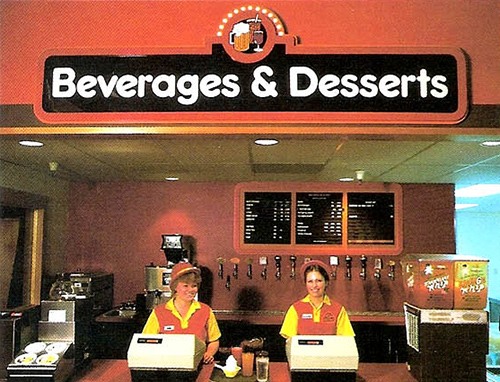
“I did the complete business plan for the rollout of the 2600,” recalls Landrum. “It was going to take them another year to get the damned thing designed and put into motion. [Bushnell] said, ‘You’ve got all this time, Gene. Go do us some business plan now on this family entertainment place.’”
Landrum tackled the job with gusto, going far beyond just an initial marketing projection. “We could really say, in some ways, that Gene was the founder of Chuck E. Cheese,” says Bushnell. “Because he was the guy I hired to bring Chuck E. Cheese into fruition. He was the guy that found the pizza recipes, he rented the facility, and hired the first people. He was very, very instrumental.”
Landrum also wrote out the menu and designed the floor plan of the first several restaurants, declining to hire an architect. “I mean, I did it in complete detail,” he stresses. “I projected the revenue stream, the gross margins, everything.”
After presenting the final plan to Bushnell, Atari President Joe Keenan, and Atari’s board of directors, Landrum received an enthusiastic response. “Nolan went crazy,” says Landrum. “He said, ‘Man, this is incredible! You’ve got to open one!’ I looked at it and said, ‘Nolan, I wouldn’t hire me to do this. This is ridiculous. I’m an electronics guy. I don’t know anything about a restaurant.’”
But Bushnell offered Landrum a large salary and the promise of making him general manager of a new division within Atari–the Restaurant Operating Division. “He gave me a buttload of money and said, ‘Go build one,’” says Landrum.
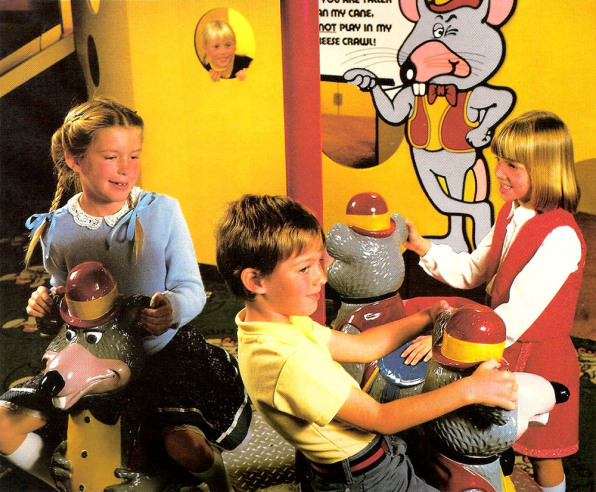
Chuck E. Is Born
During Landrum’s development process, Rick Rat’s pizza underwent several drastic transformations. First, the “Rick Rat” name would have to go. “I said, “Nolan, we’re making this a kid’s place,” Landrum remembers. “We can’t have a rat. A rat is too predatory and too lethal.” Not to mention unsanitary.
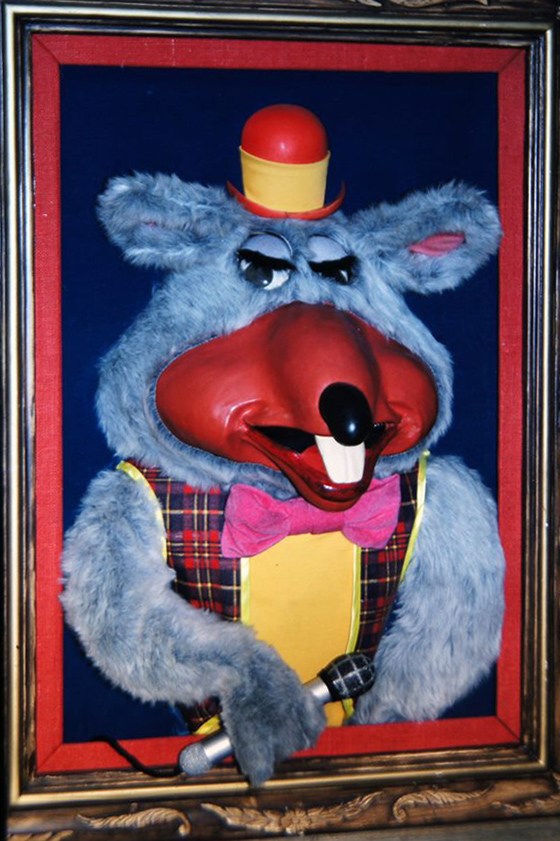
Soon Rick Rat became “Big Cheese,” but a search revealed the name was already taken by another company. Landrum and crew settled on the moniker Chuck E. Cheese–“a three-smile name,” as Bushnell likes to say. Officially, the “E” stood for “entertainment,” but the name echoed the rhythm of “Mickey Mouse.”
Landrum also emphasized, even beyond Bushnell’s vision, the necessity to provide a family-friendly atmosphere that was free of rowdy teenagers, a demographic seen as a roving, dangerous cultural wild card at the time. To solve that, all minors would have to be accompanied by adults. (A few years later, a spokesman for Pizza Time told the New York Times, “If another teenager never sets foot in our stores, that’ll be just fine with us.”)
Somewhere along the way, Bushnell’s “talking barrels” gave way to animatronic characters that would sing songs and perform comedy routines every eight minutes as diners munched on their pizza. Bushnell says the animal theme was inspired by the Enchanted Tiki Room at Disneyland, which featured a group of singing parrots. Opened in 1963, it featured the first use of Disney’s audio-animatronic technology–later used in attractions such as the Country Bear Jamboree, whose wisecracking ursine cast clearly presaged the Pizza Time Theatre experience as it would come to be.
Several people developed the crew of animated robotic characters that would later inhabit the initial San Jose restaurant’s walls, constrained at first to partial upper torsos contained within faux picture frames.
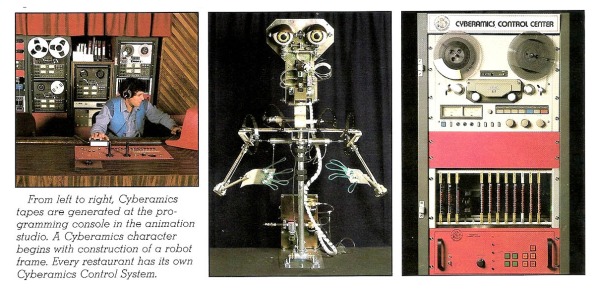
Atari artist Bob Flemate designed Chuck E. Cheese and other characters. Engineers such as Larry Emmons and Ron Milner of Atari’s Grass Valley, Calif. think tank, Cyan Engineering, provided the mechanical designs for the first characters, and an artist named Harold Goldbranson designed the flexible character skins that would aesthetically bring them to life. Mike Hatcher programmed many of the robots’ movements, which were powered by pneumatic pistons and triggered by computer control from signals on pre-recorded reel-to-reel tape that could be shipped to each store.
The initial 1977 round of characters included Crusty the Cat (soon replaced by a purple monster, Mr. Munch), an Italian chef named Pasqually P. Pieplate, and of course Chuck E. Cheese himself. Chuck E. gained most of his stage personality from his first voice actor, John Widelock, who modeled the rat’s wisecracking demeanor after a 1940s street-smart film character named Muggs McGinnis, played by Leo Gorcey in the East Side Kids series.
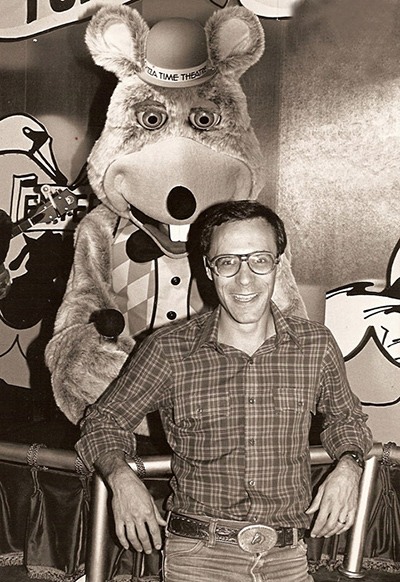
Bushnell says that the Pizza Time characters were originally designed to appeal primarily to adults, who would ostensibly watch the robotic show while they waited for their pizza order–and as their kids poured tokens into the arcade games. That would explain some of Chuck E.’s abrasive personality in the early years of Pizza Time and the hint of sexual innuendo in some of the humor. (The restaurant also catered to grown-ups by serving beer.)
Meanwhile, a much friendlier human employee would wander the restaurant in a full-bodied Chuck E. Cheese costume, a la Mickey Mouse at Disneyland, giving high-fives to youngsters–and unintentionally terrorizing every baby in the place.
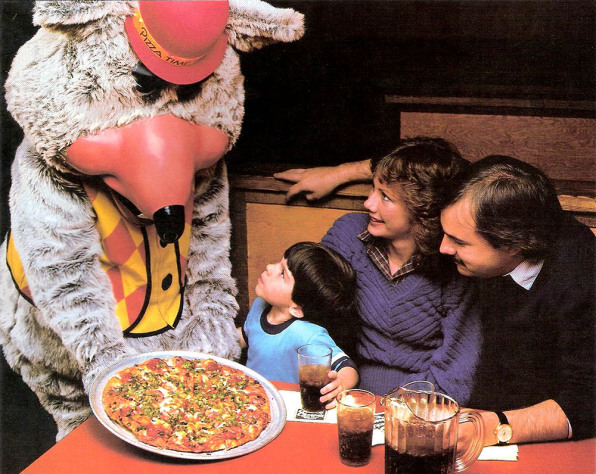
Noisy Fun
The first Pizza Time Theatre store opened on South Winchester Boulevard in San Jose on May 16, 1977. It was a community event that received a positive public reaction, with the mayor of San Jose on hand to provide her civic endorsement. Much of the Atari crew was also there to celebrate. “I remember all of us showed up at the very first day of the very first opening of the very first Chuck E. Cheese,” says John Ellis, then Atari’s VP of consumer engineering.
From the beginning, the restaurant’s atmosphere was loud and boisterous, and that became one of its trademarks. In 1981, InfoWorld described a Pizza Time location as “a whirling combination of garish lights and nonstop electronic noise that is quite unlike any other pizza parlor or video-game arcade.” Bushnell would have it no other way.
Humor and cheekiness were everywhere. Aside from the regular mechanical players, there was a seductive hippo torch singer named Dolli Dimples that would flirt with patrons for a quarter. And the 100 arcade game machines installed in the facility operated on custom tokens stamped with Chuck E. Cheese’s likeness. The reverse side bore a simple motto: “In Pizza We Trust.”
Nolan Bushnell beamed in a photo taken on that day, happy about his restaurant dream coming to life in front of him. It was a blast. But all was not well at Atari.
In 1978, Bushnell began to bristle at the restrictions being placed on some of his more far-out visions at Atari by Warner management. (John Ellis recalls Bushnell directing him, circa 1976, to investigate creating “a robot that can mix drinks and bring them to you.”) Newly wealthy, he found himself losing interest in the day-to-day operations at the company.
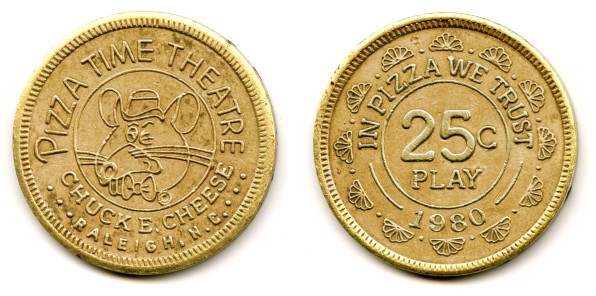
Despite the promise of Pizza Time Theatre, Warner was content to let the project die not long after the first store opened. “I had spent a lot of money and a lot of engineering time on a lot of projects that I thought were the future,” says Bushnell. “And Warner didn’t want to have anything to do with them.”
One of those projects was Pizza Time. So while he was still chairman of Atari, Bushnell bought the first Pizza Time Theatre store in San Jose and all of its intellectual-property rights from his employer for a mere $500,000. “They thought he was a sucker,” recalls Bushnell’s close friend and fellow Atari pioneer Allan Alcorn.
Bushnell hired Gene Landrum to be president of the newly formed Pizza Time Theatre, Inc., and over the next year, Landrum guided the firm with a steady and innovative hand. Meanwhile, Bushnell and Warner’s disagreements came to a head in late 1978 over the direction the company was taking its Atari 2600 console, which had faced a terrible 1977 Christmas season. As he found his role being marginalized in the company, Atari’s founder stepped away from Atari completely in early 1979 to focus on his new baby, Pizza Time.
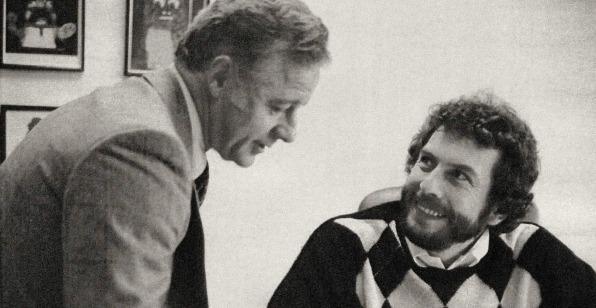
Coast To Coast
During 1978 and 1979, Bushnell pumped $1.5 million of his own money into Pizza Time to open up two additional locations that served as testing grounds for new animatronic stage acts and larger store layouts. Eventually, Pizza Time settled on a full upper-body torso robot design (thereafter referred to as “Cyberamics”) for its characters, which would entertain diners from a balcony stage in a large dining hall.
The mechanical innards of Chuck E. Cheese and his pals were obvious: They had a herky-jerky way of moving and spherical eyes that seemed to stare, even when they were blinking in slow motion. Their semi-creepy element may actually have benefited Chuck E. Cheese’s in its early years. In a way, the singing characters served as a sort of freak show in the traditional carnival sense–something crazy and novel to draw crowds, who would then become a captive audience for food and games. Bushnell, once a carny himself, clearly knew what he was doing.
Other locations followed, totaling seven by the end of the 1979 fiscal year. But Bushnell was dreaming much bigger, envisioning hundreds, if not thousands, of Pizza Time restaurants spread across the country–a potential franchise gold mine.
With expansion (and a potential IPO) in mind, Bushnell decided to offer the job of president to his old friend and partner Joseph F. Keenan, who was then serving as chairman of Atari. In September of 1979, Keenan resigned from Atari and replaced Pizza Time’s spiritual father, Gene Landrum. Landrum was none too pleased about it, but Bushnell did not treat him poorly. “[Bushnell] said, ‘I’m going to give you more stock. Here’s an El Dorado. I’ll make you executive vice president,’” recalls Landrum. “‘I want to bring Joe in, and he’ll run this.’”
Big things were in the works. Earlier, in June, Bushnell had signed a co-development deal with Topeka Inn Management, owned by Robert Brock. Brock was well known at the time as a large franchisee operator of Holiday Inn locations, and he announced plans to build 285 Pizza Time Theatre stores in 16 states over five years. Other franchisees lined up behind Brock, and the future looked bright.
During 1980, Pizza Time Theatre flourished, adding dozens of stores to its portfolio, including corporate-owned locations and franchise outlets all across the U.S.–and even a few internationally. With Keenan in command, things grew quickly (and then quickly out of hand) at Pizza Time. The deal with Brock came back to haunt the company that year when Brock’s firm, which had received training on how to run Pizza Time locations, reneged and decided to open up its own competing chain of restaurants called Showbiz Pizza.
Showbiz was the most successful of numerous Pizza Time knock-offs that sprung up in the 1980s, including Bullwinkle’s Family Restaurant (with robotic moose and squirrel), Celebration Station, Fair Play Pizza Theater, Major Magic’s All Star Pizza Review, and Razz-Ma-Tazz. “We had 20 copiers who were all putting up stores,” Bushnell says.
The impetus for Brock’s gambit was his discovery of apparently superior animatronics technology developed by Aaron Fechter of Creative Engineering. Fechter developed a full-body life-size animal band called the Rock-Afire Explosion that featured smoother movements than the Chuck E. Cheese Cyberamics characters. Pizza Time immediately sued Brock’s firm, and after two years of legal battles, eventually won out with a profit-garnishing judgment against Showbiz. But it came too late to be useful.
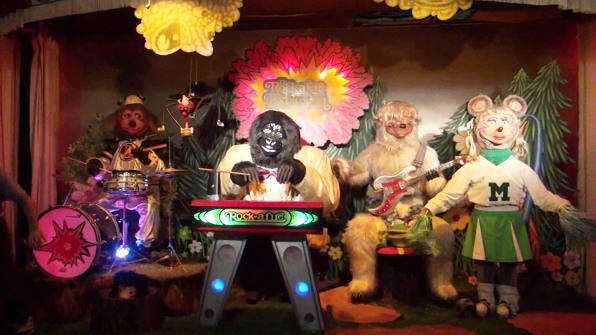
In April 1981, under Keenan’s guidance, Pizza Time hit another milestone by going public. But Bushnell was beginning to lose interest into the mundane elements of Chuck E. Cheese’s routine business. “It’s really about being an adventurer and staying on the steep part of a learning curve for me,” he says. “I’ve always felt that once something is figured out and running, a lot of people can learn it. Why should I do it?”
Bushnell’s new adventure was Catalyst, a pioneering high-tech incubator firm that soon became host to over a dozen small companies. He played a hand in funding and running all of them, becoming chairman of at least seven corporations. One, a personal-robot startup called Androbot, particularly captivated Bushnell. He poured money into it, eventually taking out several multi-million-dollar personal loans while using the escalating value of his Pizza Time stock as collateral. On top of that, Pizza Time itself was borrowing money–at least $50 million of it–to fund its operations.
Meanwhile, a non-compete agreement Bushnell had signed with Atari when he left that firm was about to expire in 1983, and he saw Pizza Time as the perfect vehicle to bring a new video game company into the world. Pizza Time acquired a small game development firm named Videa with the aim of shaping it into a disruptive force in the market. It would emerge as Sente Technologies later that year.
On top of that, Bushnell was experimenting with yet another Pizza Time division called Kadabrascope. It aimed to reinvent how cartoons were animated by using a computer to fill in between hand-drawn key frames of animation, providing smoother animation with less cost. The company planned on making a Chuck E. Cheese TV special that would be ready by Christmas, but the technology didn’t pan out.
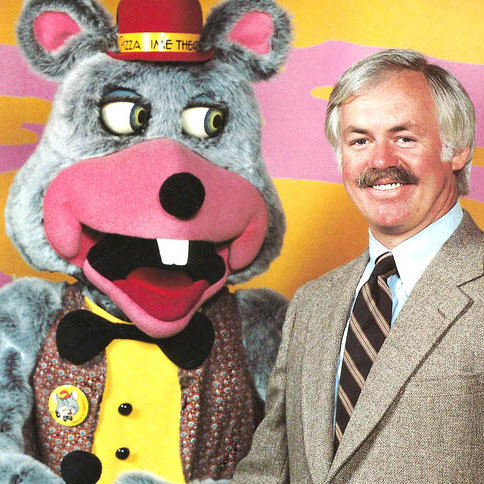
More and more, Bushnell was trying to turn Pizza Time into a new Atari, and as he did, the company began to lose its original focus on kid-oriented dining. In the company’s 1982 annual report, Bushnell wrote, “We believe that 1983 will be a time of growth and chance in which the transition from a specialized restaurant concept to a diversified leisure company will be evident.”
In early 1983, Pizza Time’s financial situation was precarious enough that one slight push in the wrong direction could send Bushnell’s entire business empire crashing down. That push came in the summer when a U.S. tech stock crash spooked investors. Among its casualties was the once-mighty Atari, which became a shadow of its former self. The fear of investing in tech dried up lines of credit for Bushnell’s firms. Meanwhile, Pizza Time’s stock fell from a high of $26 per share down to $4, then later to $2.50.
Not long after, Pizza Time revealed that it had been losing money over the previous three quarters. With over 240 locations across the country, sometimes with smaller cities playing host to multiple restaurants, and a half dozen competitors like Showbiz entering the market, the novelty of the Chuck E. Cheese concept wore itself out by late 1983. There were several shuffles in management, with Bushnell stepping in as president for a time, but it was too little, too late. In January 1984, Bushnell resigned as chairman and CEO of Pizza Time. In March, the firm filed for bankruptcy protection.
“What happened with Chuck E. Cheese was very simple,” Bushnell says. “We overexpanded … Chuck E. Cheese was so new that when we would first open a unit in St. Louis, you wouldn’t have enough capacity, it was just, ‘Okay, bar the door.’” But that lasted for about a year and a half. Then people would settle down and they didn’t need to go to Chuck E. Cheese every time grandma came to town. They didn’t need to go to Chuck E. Cheese once a month. They found that we’ll do the kids’ birthdays and we’ll go somewhere on special events, but the frequency of visits dropped from 10 a year to three a year.”
Showbiz Pizza suffered too during that era, but managed to hang on. In 1984, Showbiz agreed to purchase Pizza Time Theatre, Inc. They completed their merger in 1985 and later combined their robotic stage shows into one act. Ultimately, the powerful Chuck E. Cheese brand won out, and the entire chain of Showbiz Pizza locations became disciples of the Chuck.
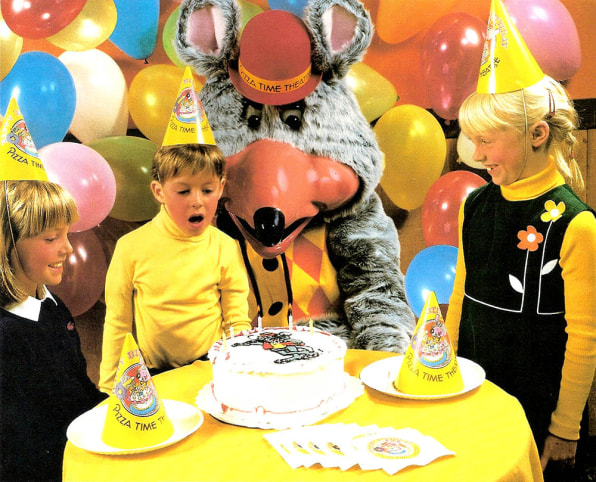
Pizza Time Forever
Today, the Chuck E. Cheese restaurant chain lives on as a descendant of that financial shotgun marriage, with over 500 locations worldwide–and growing. It still has value, too: In 2014, Apollo Global Management bought the chain’s parent company for $1.3 billion. Recent rumors say it may be sold again, or go public.
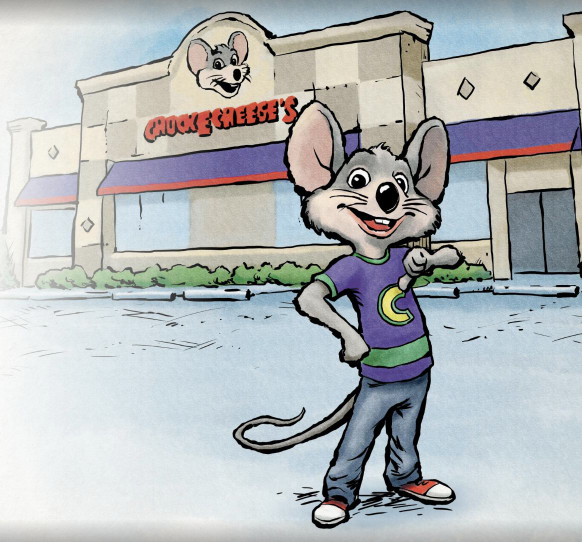
But make no mistake: Times have changed. Over the years, Chuck E. Cheese himself has gradually changed from a sly cigar-chomping adult to a guileless, skateboarding adolescent, reflecting a steady shift away from Bushnell’s attempts to woo adults to the franchise.
The singing robots long ago received much more friendly facelifts and less piercing eyeballs. Now the chain is beginning to distance itself from its signature animatronic stage show. Reportedly, some restaurants only display pre-taped puppet sketches on flat-screen TVs that flank a lone automated Chuck E. Cheese figure.
Coincidentally, Chuck E. Cheese is backing away from robotics just as the idea of restaurant animatronics themselves have recently resurfaced in pop culture thanks to Five Nights at Freddy‘s, a 2014 horror-themed video game homage to Showbiz and Pizza Time-like mechanical characters. The curdled childhood memories of a generation are now coming out as nostalgic pastiches, and there is likely more to come.
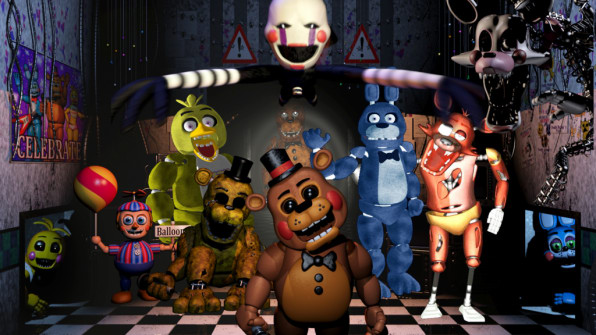
As for Nolan Bushnell–well, after all these years, he still has a thing about restaurants. He’s founded or taken over several of them over the past four decades, and his wife’s family still runs one in Silicon Valley called Lion & Compass. In 2006, he even tried to combine meals and games again with uWink, a restaurant where the tables were equipped with touchscreens.
Over his almost half-century career, Bushnell has never stopped chasing the ultimate combination of entertainment, socializing, food, and drink. Pong was was the first two-player-required video game, and often found a home in establishments where edibles and beverages were served. Androbot demoed its robot at CES by having it fetch a beer for Bushnell onstage. PlayNet, a 1990s venture, made net-connected jukeboxes for bars. Bushnell even explained Etak’s amazing 1980s car-navigation system by fantasizing about the day when it would help you find the nearest good, cheap sushi joint.
And maybe that’s the secret behind Chuck E. Cheese’s enduring relevance. It’s not about technology or singing animals. The place is a cultural Trojan horse that brought families together, helped arcade games become acceptable, and made eating into family entertainment. For all that’s changed about the company, the idea behind the unlikely dream that Bushnell turned into a business in 1977 remains resonant.
A 40th-anniversary tribute to Nolan Bushnell’s improbable restaurant chain, which combined raucous high-tech entertainment, arcade games, and kid-oriented food into something altogether new.
In May 1977, a new pizza place opened for business in San Jose, California. At the time, calling it “unique” might have been an understatement. The brainchild of Atari cofounder Nolan Bushnell–and, initially, an arm of that company–it featured entertainment provided by a cast of robotic characters led by a giant cigar-smoking rat with a bowler, buck teeth, and a Jersey accent. The place–as much a strip-mall Disneyland as an eatery–was called Pizza Time Theatre, and the rodent was known as Chuck E. Cheese.
Fast Company , Read Full Story
(828)














